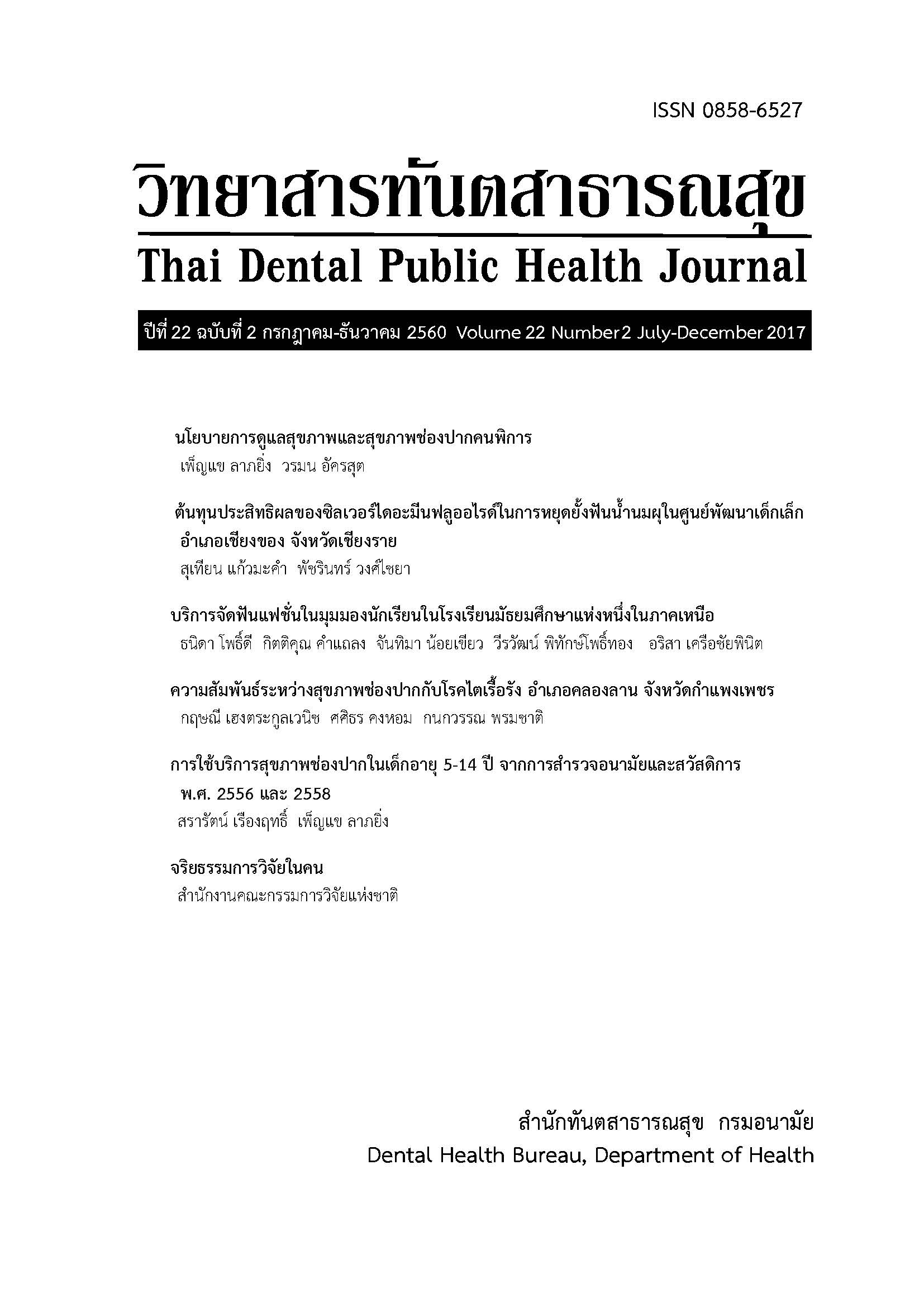Fashion braces services in the perspective of students in a northern secondary school
Main Article Content
Abstract
This qualitative research aimed to study students’ opinions on fashion braces service in a northern secondary school. Key informants were seven secondary students having fashion braces experience. In-depth interviews, observations, and focus group discussion were used to gather the information in three main issues of service types, provision, and access during October 2016 through February 2017. The fashion braces service was categorized into two types which were fixed and removable appliances. The fixed appliance was divided into four subtypes which were bracket or O-ring, chain, colored tube, and wire types. The removable appliance as retainer was divided into 2 subtypes of with and without pink acrylic part. Their providers were their school fellows and young women having shops near the school. As the students’ perception, they both used same brace technique but differed in experiences, prices, and promotion. The students used criteria choosing the service which were friendly provider, high performance, and equipments were ready to respond their demands; sufficient services; easily travel to service place; convenient appointment could be easily made; and payable prices comparing to expensive dentists’ orthodontic services.
Downloads
Article Details
References
2. Van der Linden FPGM. Use of removable appliances. In Orthodontic concepts and strategies. UK.: Quintessence Publishing Co, Ltd; 2004. p.33-48.
3. Cobourne MT, DiBiase AT. Contemporary removable appliances and contemporary fixed appliances. In Handbook of orthodontics. China: Elsevier; 2010. p.209-261.
4. Editorial department. Fashion brace, amendment is not enough. Chaladsue 2017; 23 (195): 9-13. (in Thai).
5. Rityoue A, Sasiwongsaroj K. Pseudo-orthodontics among Thai teenagers and its effects on oral health. Thailand Journal of Dental Public Health 2009; 14(1): 7-19. (In Thai)
6. Manager online. Fashion braces Dangerous! Ministry of Public Health found many poison. (on line). 2008 May 8 [cited 2017 Oct 1]; Available from: URL: http://www.manager. co.th/Qol/ViewNews.aspx?NewsID=9510000053805 (in Thai).
7. Sriarunotai S, Boonyagul S. Ion released fromfashion orthodontic brackets and standard-ized orthodontic brackets in artificial saliva.
BHST. 2016; 14 (2): 40-46.
8. Zarzycka-Kogut K, Pucek M, Szymanska J. Orthodontic treatment – complications and preventive measures. Pol J Public Health 2014; 124 (2). p.103-106. [cited 2017 Oct 1]; Available from: URL: https://www.degruyter. com/downloadpdf/j/pjph.2014.124.issue-2/ pjph-2014-0024/pjph-2014-0024.pdf
9. Vachirarojpisan T. From orthodontics treat- ment favor to “fashion brace”, not worth it. Bangkok: Usa Printing Co., Ltd; 2009. (in Thai).
10. The Phnom Penh Post. Faking it: the craze for ‘fashion braces’. (on line). 2016 Aug 26 [cited 2017 Oct 1]; Available from: URL: http://www.phnompenhpost.com/post-weekend/faking-it-craze-fashion-braces
11. Penchansky R, Thomas JW. The concept of access: definition and relationship to consumer satisfaction. Medical Care 1981; 19(2):127-140.
12. Proffit WR, Sarver DM. Contemporary orthodontic appliances. In Contemporary orthodontics. 5th ed. Canada: ELSEVIER; 2013. p. 347-389.
13. Editorial department. Orthodontics treatment, think carefully before reaching a decision. Chaladsue 2001; 8(46): 24-31. (in Thai).
14. Pothidee T. Body, consumption, and braces wearing of young adolescents in Bangkok. Thesis of Master of Arts. Mahidol University, Nakornpathom; 2007.
15. Preoteasa TC, Ionescu E, Preoteasa E. Risks and complications associated with orthodontic treatment. In Bourzgui, F. (Eds). Orthodontics- basic aspects and clinical considerations. China: InTech; 2012. p. 403-428. [cited 2017 Oct 1]; Available from: URL: http://www. intechopen.com/books/orthodontics-basic-aspects-and-clinical-considerations/risks-and complications-associated-with-orthodontic-treatment.
16. Ramanathan S, Ramasamy N. Avoidable complication and patient care during orthodontic treatment. J. Pharm. Sci. & Res. 2015; 7(12): 1096-1098. [cited 2017 Oct 1]; Available from: URL: http://www.jpsr.Phar mainfo.in/Documents/Volumes/vol7Issue12/jpsr07121505.pdf
17. Yun-Wah Lau P, Wong Wing-Kit R. Risks and complications in orthodontic treatment. Hong Kong Dent J 2006; 3(1): 15-22. [cited 2017 Oct 1]; Available from: URL: http:// www.hkda.org/hkdj/V3/N1/v3N1P15FA2.pdf
18. Cobourne MT, DiBiase AT. Risk of orthodontic treatment. In Handbook of orthodontics. China: Elsevier; 2010. p.17-22.


